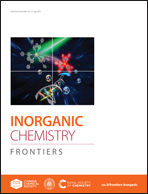Potent oxidation of DNA by Ru(ii) tri(polypyridyl) complexes under visible light irradiation via a singlet oxygen-mediated mechanism†
Abstract
Since Ru(II) tri(polypyridyl) complexes can bind DNA in the groove, the chemistry of metallo-groove-binders has been extended to many applications such as artificial photonucleases and DNA recognizers. Here we found that the major product was N-(2-deoxy-β-D-erythro-pentofuranosyl)-spiroiminodihydantoin (dSp) when the nucleoside 2′-deoxyguanosine (dG) was exposed to the visible light irradiation of Ru(II) tri(polypyridyl) complexes including Ru(bpy)32+ (bpy = 2,2′-bipyridyl), Ru(OP)32+ (OP = 1,10-phenanthroline) and Ru(DIP)32+ (DIP = 4,7-diphenyl-1,10-phenanthroline). Interestingly, we found that in the oxidation of dsDNA the major oxidation product is 8-oxo-7,8-dihydro-2′-deoxyguanosine (8-oxodG) instead of dSp. The formation of dSp and 8-oxodG increased significantly in D2O and decreased markedly with the addition of NaN3. [18O]-Labeled 8-oxodG was also found to be produced more than non-labeled 8-oxodG under an 18O2 atmosphere. The above results clearly indicated that 1O2 was the major oxidant during the oxidation of both dG and dsDNA by the irradiation of Ru(II) complexes, which was further confirmed by both ESR spin-trapping and UV methods. Among the above three Ru(II) complexes, Ru(DIP)32+ is the most efficient photosensitized generator of dG oxidation products, while in the oxidation of dsDNA, Ru(bpy)32+ is the most effective. This is the first report that the irradiation of Ru(II) polypridyl complexes with visible light can induce potent oxidation of dG and ctDNA to the more mutagenic product dSp and 8-oxodG via an 1O2-mediated mechanism. These findings should provide new perspectives for future investigations on whether ubiquitous Ru(II) complexes could cause oxidatively generated DNA damage in cellular models.



 Please wait while we load your content...
Please wait while we load your content...